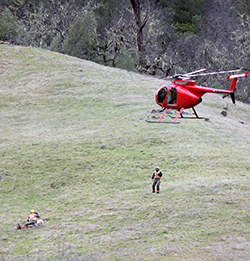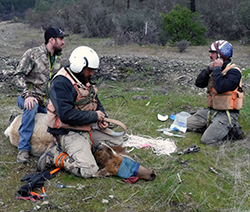


The California Department of Fish and Wildlife (CDFW) recently launched the first phase of a multi-year study of tule elk in Colusa and Lake counties. In partnership with the University of California, Davis and the Rocky Mountain Elk Foundation, and with the assistance of capture specialists from Leading Edge Aviation, researchers used helicopter net guns to capture and place satellite collars on 45 tule elk.
The technique of using DNA extracted from fecal pellets to study wildlife populations is a relatively new, non-invasive approach that minimally disturbs animals and enables surveys in low-visibility habitats where sight-based surveys would be relatively ineffective. It is also less costly than other survey methods, and therefore can be used more frequently.
While fecal DNA analysis has been used to estimate abundance and other population parameters in deer herds in California since 2011, this study will be the first application of the technique to free-ranging tule elk. The study results will guide future elk conservation planning efforts.
Tule elk are a native subspecies of elk unique to California. Prior to the arrival of European settlers, they numbered more than half a million statewide, but the population rapidly declined in the mid-1800s due to unregulated market hunting and habitat loss. In 1875, a ranch owner in Kern County took efforts to protect the last remaining tule elk and allowed them to multiply on his property, likely saving them from extirpation.
Since 1975, CDFW has captured and relocated more than 1,500 elk. As a result, there are an estimated 5,100-plus tule elk distributed in 22 herds throughout California today. See more information about the distribution, range and history of this unique animal in California.